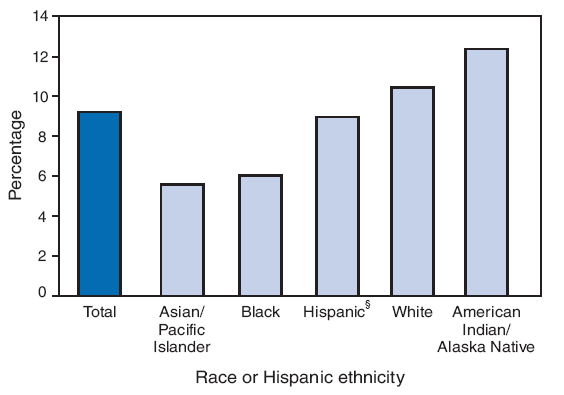|

QuickStats: Percentage of Large-for-Gestational-Age*
Births,† by Race or Hispanic Ethnicity --- United States, 2005

* Birthweight at or above the 90th percentile for a given gestational age.
† Includes only singleton live births.
§ Might be of any race.
Infants born large for their gestational age (LGA) are at increased risk for birth complications, such as obstructed labor,
and for obesity later in life. Information from U.S. birth certificates for 2005 shows that a greater percentage of American
Indian/Alaska Native women gave birth to an LGA infant (12%), followed by white (10%) and Hispanic women (9%). Black
and Asian/Pacific Islander women were least likely to have given birth to an LGA infant (6%).
SOURCES: National Vital Statistics System. Annual natality files. Available at
http://www.cdc.gov/nchs/births.htm.
Oken E, Kleiman KP, Rich-Edwards J, Gillman MW. A nearly continuous measure of birth weight for gestational age using
a United States national reference. BMC Pediatr 2003;3:6. Available at
http://www.biomedcentral.com/content/pdf/1471-2431-3-6.pdf.
Use of trade names and commercial sources is for identification only and does not imply endorsement by the U.S. Department of
Health and Human Services.
References to non-CDC sites on the Internet are
provided as a service to MMWR readers and do not constitute or imply
endorsement of these organizations or their programs by CDC or the U.S.
Department of Health and Human Services. CDC is not responsible for the content
of pages found at these sites. URL addresses listed in MMWR were current as of
the date of publication. |
All MMWR HTML versions of articles are electronic conversions from typeset documents.
This conversion might result in character translation or format errors in the HTML version.
Users are referred to the electronic PDF version (http://www.cdc.gov/mmwr)
and/or the original MMWR paper copy for printable versions of official text, figures, and tables.
An original paper copy of this issue can be obtained from the Superintendent of Documents, U.S.
Government Printing Office (GPO), Washington, DC 20402-9371;
telephone: (202) 512-1800. Contact GPO for current prices.
**Questions or messages regarding errors in formatting should be addressed to
mmwrq@cdc.gov.
Date last reviewed: 11/20/2008
|
